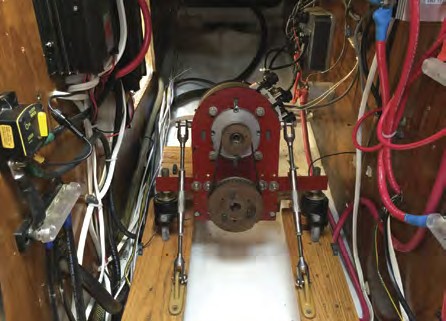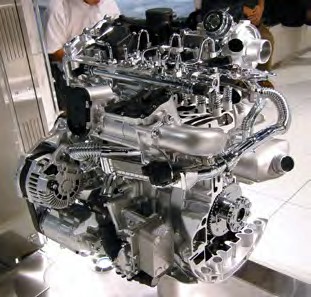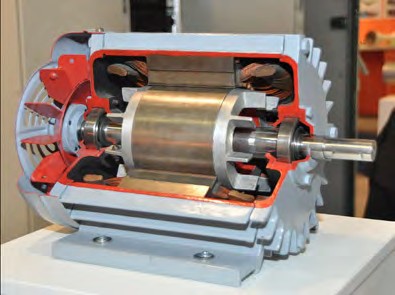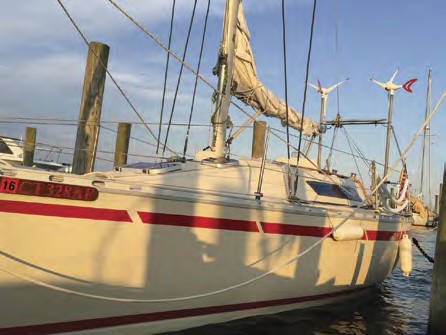The Electric Auxiliary Sailboat has Come of Age
By Derek Rupe
Electric powered boats feel like a new idea, but in fact pre-date internal combustion engines and the entire petroleum industry. In 1839, inventor Moritz von Jacobi loaded twelve passengers into a 24-foot boat on Russia’s River Neva to demonstrate his new invention. The high society of Saint Petersburg, including Tsar Nicolas the First, lined the riverbanks and watched as the electric motor propelled the vessel at three knots to high praise. However, by the 1920s almost all electric powered boats were replaced by those with internal combustion engines.

The 10kW electric motor aboard the author’s Beneteau First 30 Showtime is smaller, lighter, and much more efficient than the original diesel auxiliary. © Captineer.com
Gasoline and diesel power ruled the waves for the twentieth century. Now as technology changes again, and as environmental concerns are starting to effect consumer choices, electric vehicles are here to stay. The technology that has been developed to make electric cars a viable option can now make electricity the optimal power source for boats.
Three years ago, I was motoring out of New London harbor in our 1983 Beneteau First 30 Showtime on my way to winter storage up the Connecticut River. Nearing Ledge Light, the engine started losing power and running rough. I quickly popped the throttle lever into neutral, where the old diesel sputtered for a few seconds before stalling, never to run again.
 Attempts to repair the engine were futile. The Volvo Penta MD7B was salt water-cooled and there was too much corrosion inside the block to rebuild. We looked into repowering options, but it was going to be very expensive. I started feeling like Icarus with wax wings for sailing dreams; my sun was owning a sailboat and being able to afford it.
Attempts to repair the engine were futile. The Volvo Penta MD7B was salt water-cooled and there was too much corrosion inside the block to rebuild. We looked into repowering options, but it was going to be very expensive. I started feeling like Icarus with wax wings for sailing dreams; my sun was owning a sailboat and being able to afford it.
Diesel engines require many ancillary systems to function.
A new Beta Marine 15hp diesel was the best option we could find, but was going to cost about $15,000 with all the needed parts, and that was with me doing most of the work. We didn’t want to bolt an outboard to the transom, and used inboards mostly look like the disaster we currently had with a fresh coat of spray paint on them.
There was, however, another option – one that did not use any fuel, make any noise, or produce any exhaust fumes. It also would not require raw water or a transmission. Most importantly, it was an option we could afford.
Once we decided to repower in electric, it seemed like the natural choice for a sailboat. The battery weight, if properly balanced, could be an advantage to ballasting and would improve Showtime’s sailing characteristics. Range would be the largest cost variable in battery type and size. To start out, range wasn’t required since I could usually sail. We weren’t aware of all the advantages at the time, but came to find that a properly programmed system could recharge up to 400 watts by freewheeling the propeller while sailing. Range was also very much a function of speed, and could be greatly extended by slowing down.
Designing the System
There were a few companies building drives, but they were either very expensive or not taking full advantage of new technologies. Our first system was bought piecemeal. The heart of the system, the motor and controller, came from Thunder Struck EV out of California. The drive is a brushless three-phase asynchronous permanent magnet multi-stator motor with sine/cosine encoder. The motor only has one moving part, the spindle shaft with attached cooling fan, spins in high precision bearing. These motors are common in industrial applications where they are required to operate with alternating speeds in both directions for 50,000 hours with no maintenance. The motor’s ability to change its own direction removes the need for a transmission. The motor, coils, and controllers are all electric so there are no mechanical parts or relays to wear out. The motor and controller setup aboard Showtime has been remounted multiple times, reprogrammed and pushed to edge of its operating limits, and has always operated perfectly over the last three years. In deciding on this system, and in design changes we’ve made, simple robust engineering has been the consummate goal.
 In the first season we found the electric system delightful. The motor scooted us along silently and with more torque and responsive smooth directional change that no transmission could compete with. There was never any start-up anxiety and the motor was always ready to go with its idle effectively off. In close corridors and tight spots the electric motor is a dream, going from forward to reverse instantly.
In the first season we found the electric system delightful. The motor scooted us along silently and with more torque and responsive smooth directional change that no transmission could compete with. There was never any start-up anxiety and the motor was always ready to go with its idle effectively off. In close corridors and tight spots the electric motor is a dream, going from forward to reverse instantly.
Electric motors are simple and robust
The reliability advantage starts with how the motors are made and what they are used for. An electric motor is at least an order of magnitude less complicated than a diesel, and has about 2% as many moving parts. Less to break means less breaks, but it’s also the nature of the power delivery. Internal combustion motors work by containing quick explosions, harnessing the power, dissipating the heat, misting fuel, or mixing fuel, introducing air, removing exhaust, valves going up and down, oil pumping and water impelling, and on top of it all it requires an electric motor to start it. All the little things in every one of those systems have to work perfectly all at the same time. Electric power has a static controller, wiring, fuses, and the motor just has one job: to spin. Magnets and coils interact, and the motor spins. It’s easy, it’s simple, and the lack of interdependent systems means it can keep working for years and years.
Addressing Range Anxiety
With all the wonderful qualities of an electric motor, there is a dark underside to electric power. Range anxiety can affect even the most stoic and well-planned sailor. A trip that was only expected to take three hours takes four because of a headwind, so the storage batteries start running low. A short overnight charge at a marina isn’t long enough to fully restore the battery banks, so there is less range than anticipated. There is no immediate and universal solution to range anxiety. Larger battery banks can alleviate it, but there will always be some range limits if batteries are the only solution adopted.
Generators can add power while underway, reducing or replacing the draw on battery banks. Solar, wind, and current can contribute while the motor is running, and recharge the batteries while the motor is off. If conditions allow, enough power can be harvested through these systems to have perpetual range. The key ingredient is sailing. By sailing the boat, current is captured through the propeller. Most points of sail will improve apparent wind, making wind regeneration more effective as well. Solar is more about proper mounting, system size, and time, but is a good way to add power during daylight hours.
As much as I love my electric motor, I always prefer to sail. We sail more in general, but also more on a given trip. Because power cannot be pumped at a dock, recharge time has to factor in. On Showtime, with good conditions the power consumption of an hour of motoring at five knots can be regenerated in four hours of sailing in 15 knots of wind. Current power is more effective on a broad reach to a run, and wind power is more effective on a close reach to a beam reach. Wind power also has much higher effectiveness at higher wind speeds, whereas current is capped at hull speed. Solar depends on weather conditions and sun angle, but is relatively consistent once those dependent factors are understood. At five knots, Showtime burns about 1,750 watts with another 400 watts in instruments and lights for the four hours of sailing and one hour of motoring.
To regenerate, Showtime has a 200-watt solar system that effectively generates 80 watts (we are assuming this five-hour trip takes place during the day). Showtime also has 800 watts of wind turbines, effectively generating 120 watts in 15 knots of wind. Water spinning the propeller in the regenerative mode at 7 knots of current can produce 300 watts of power. So, we are able to make about 500 watts an hour for four hours, and 200 watts for the one hour we motored. The grand total is 2,200 watt hours of generation to cover the 2,150 watt hours expended. With minor charge losses, this puts you just about even.
For some folks, that ratio is not as ideal for how they want to boat. In those cases the easiest solution in a backup gen-set. Most trips won’t ever require it to be fired up, and large battery banks can make this even less necessary. But for those who don’t want to ever suffer from range anxiety, it can be a nice security blanket just knowing that it’s there.
This ratio is great for those who don’t have large range requirements and would prefer less weight to more range (the electric system can be much lighter). There is battery technology for every application and budget (from $400 to as much as you can imagine).
Battery technology is too complicated to get into in all the details here. Basically, there are good traditional lead acid and glass matt batteries that can make good battery banks. The main advantage of these types of batteries is cost and availability, with drawbacks being weight, power density, time to recharge, lifetime charge cycles, and voltage loss over time.
Batteries made with lithium are the hot new battery of the future and solve, or nearly solve, all the issues with the traditional battery types. Technology from the mobile computing revolution and early versions of the modern electric car has created very good battery technology. However, the manufacturing facilities to make large lithium batteries affordable are currently being built. This means we can reasonably expect these batteries to continue to improve at a steady rate, while seeing large cost decreases in the near future.
I think the best course of action is to realize that lithium batteries, or a better battery alternative, will be available at an affordable cost in three to five years, and currently are good but expensive. For those who want the best now, good lithium batteries can be acquired at a cost premium. For those who want an economical transition, a switch to electric can be accomplished with more traditional batteries.
When we converted Showtime we only had a 4.8 kWh battery bank the first season, which was only good for about 15 nautical miles of range at cruising speed of about 5 knots. At slow speeds of 3.5 to 4.5 knots we could have 50 nautical miles of range, but who wants to go that slow? The flip side is that at 7.5 knots (the hull speed), range is reduced to about 3 nautical miles. We stayed around New London that season, going to Block Island a few times. I was a little pensive about the new system, and didn’t want to rely on it too heavily until we had worked out any faults.
Because we had no alternator to charge house batteries, we had a solar system charging into the 12-volt house system. That year the whole system was still new to us, yet we never ran out of power. Even so, we still weren’t comfortable cruising away from home waters, and we always made sure to leave enough power to motor into our marina.
Upgrading the System
The next season, we made some improvements to the system. We upgraded to an 11.7 kWh battery bank and also added two random three-phase wind turbines in series. We were able to achieve terminal charge voltage for the 48-volt system, however, watts-in were very disappointing in anything under 25 knots of wind.
With a year of sea trials and some system upgrades, we felt comfortable enough to cruise up to Maine for a six-week trip that summer. We were not able to charge enough while sailing to go perpetually, so instead of anchorage and mooring exclusively we had at least one marina slip night per week to recharge the motor bank (the house bank was fine with just solar).
We had to plan a little more strategically, and were stressed out a few times about having enough range. We went a little too far north and lingered a little too long (due to weather) and found our return trip a bit tight for time. We had about six days to get from Rockland, Maine back to New London, Connecticut. Conditions from Portland to Sandwich, Massachusetts were mid-August flat, with no wind at all for long periods. We motored and sailed from Portland to Isle of Shoals.
The next day we motored all the way from Isle of Shoals of Gloucester, and had to start slowing down in the afternoon to increase our range. In Gloucester we were able to get about 80% recharged, and had another day of no wind.
We motored all the way across Massachusetts Bay and Cape Cod Bay, but at about 8 nautical miles outside of Sandwich we ran out of juice. The low voltage alarms started beeping, and I had to decide if I wanted to move some of our house batteries over to the motor side. I had already run these wires anticipating just such an event, but before I started rewiring, the wind picked up for a little 10-knot southerly blow over the Cape before sunset.
We turned on the current regeneration through the spinning propeller and sailed some fast tacks upwind to Sandwich. About two hours later we were at the mouth of the Cape Cod Canal, and our recharging had recovered enough voltage that we were able to motor up the canal to the marina, and arrived early enough to get a full charge.
This past winter, the whole system was rebuilt and re-programmed a third time. A new product became available: a small marine wind turbine with a 48-volt self-regulated output. These replaced the random AC turbines and are much more efficient. The batteries were reconfigured and brought up to 16.5 kWh. The recharge under sail was improved, and the solar system was configured for the 48-volt drive system and doubled in size. The 12-volt house system was removed and replaced with voltage rectifiers. Now the range is variable, depending on recharging while sailing. If the boat can be sailed 80% of the time it can recharge enough to have infinite range, with a starting range of 100 nautical miles at 5 knots. One of my system goals was to be able to motor to Block Island and back, about 60 nautical miles, at 5 knots. We were able to do that this past summer.
 So, I’ve decided to start promoting electric power and using my experience to help other people enjoy all the advantages of electric sailing. My hope is to find good boats with bad motors and repower and restore them. I would also provide installation and setup services for electric motor, regen systems, and marine electronics. I invite everyone to visit my website, Captineer.com, and please contact me with any questions. The prototype Beneteau First Showtime is up for sale, although we have more electric boats that can be demoed in New London.
So, I’ve decided to start promoting electric power and using my experience to help other people enjoy all the advantages of electric sailing. My hope is to find good boats with bad motors and repower and restore them. I would also provide installation and setup services for electric motor, regen systems, and marine electronics. I invite everyone to visit my website, Captineer.com, and please contact me with any questions. The prototype Beneteau First Showtime is up for sale, although we have more electric boats that can be demoed in New London.
In addition to water current spinning the propeller while sailing, Showtime uses wind power and a solar panel (mounted between the twin turbines) for battery charging. © Captineer.com
We have low cost, low range systems that are perfect for racers, day sailors, and weekenders not concerned about motoring range, as well as cruising systems for boats up to 40 feet, and recharging systems to make infinite range cruisers.
We are currently seeking customers interested in repowers, wind and solar systems, and those interested in purchasing electric re-power and restored sailboats. But don’t limit your inquires to those subjects – we’d love to show and share the potential of these systems with anyone who is interested.



